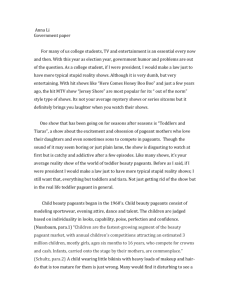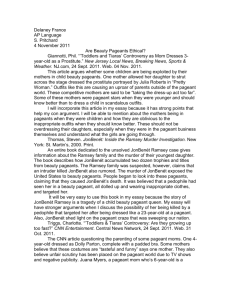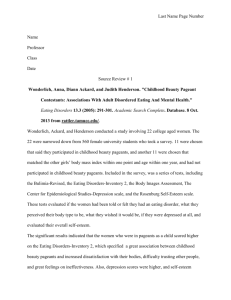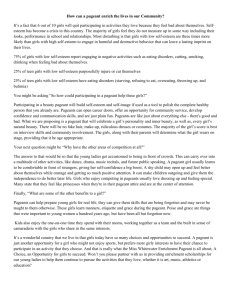ENG 101 Research Paper Final Draft
advertisement
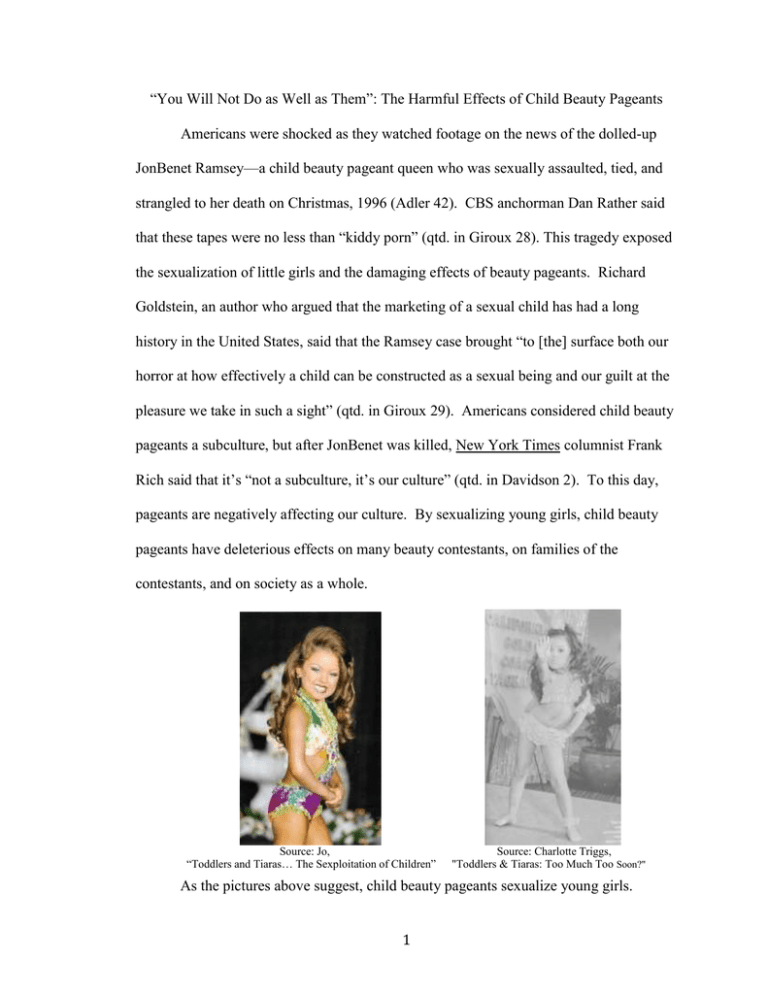
“You Will Not Do as Well as Them”: The Harmful Effects of Child Beauty Pageants Americans were shocked as they watched footage on the news of the dolled-up JonBenet Ramsey—a child beauty pageant queen who was sexually assaulted, tied, and strangled to her death on Christmas, 1996 (Adler 42). CBS anchorman Dan Rather said that these tapes were no less than “kiddy porn” (qtd. in Giroux 28). This tragedy exposed the sexualization of little girls and the damaging effects of beauty pageants. Richard Goldstein, an author who argued that the marketing of a sexual child has had a long history in the United States, said that the Ramsey case brought “to [the] surface both our horror at how effectively a child can be constructed as a sexual being and our guilt at the pleasure we take in such a sight” (qtd. in Giroux 29). Americans considered child beauty pageants a subculture, but after JonBenet was killed, New York Times columnist Frank Rich said that it’s “not a subculture, it’s our culture” (qtd. in Davidson 2). To this day, pageants are negatively affecting our culture. By sexualizing young girls, child beauty pageants have deleterious effects on many beauty contestants, on families of the contestants, and on society as a whole. Source: Jo, “Toddlers and Tiaras… The Sexploitation of Children” Source: Charlotte Triggs, "Toddlers & Tiaras: Too Much Too Soon?" As the pictures above suggest, child beauty pageants sexualize young girls. 1 Beauty pageants, in which women dress up and model in different types of clothing, have a long history in the United States, beginning in 1854 with the first modern American pageant. Child beauty pageants, on the other hand, have developed over the past few decades into the phenomenon that they are today. Child pageants began in the 1960s, but until the 1990s they were most prevalent in the southern states. Since the 1990s, however, kiddie pageants have spread all throughout the nation. Every year, 250,000 American girls between infancy and puberty strut across the stage in more than 5,000 beauty pageants (Hollandsworth 2). Today, judges of these pageants are looking for “the complete package,” which includes looks (hair, makeup, and outfit), poise, personality, confidence, etc. Numerous girls and families have been sucked into this spectacle. Since child beauty pageants first began, these spectacles have become increasingly controversial. But many parents of young pageant girls and people in the pageant business believe that the beauty contests benefit the girls and society. After the murder of JonBenet, some Americans began to realize the detrimental effects that these child pageants have on the young girls. Today, many Americans oppose child pageants because they have damaging psychological effects and they sexualize young girls. But many parents, particularly the mothers of the pageant stars, instead say that pageants promote their daughters’ self-confidence and self-esteem. Another argument used by child beauty pageant advocates is that the thousands of dollars they invest in the pageant industry stimulates the economy by providing more people, like hairdressers and pageant coaches, with jobs. They also justify the costs paid for the pageants by saying that their 2 daughters choose and desire to be in pageants. Some of these beliefs are erroneous, and in any event, the harmful effects of the kiddie pageants outweigh the potential benefits. Contrary to what supporters of child beauty pageants believe, these pageants lower the self-esteem of the young girls. For example, former child beauty pageant queen, Nicole Hunter, prematurely confronted her sexuality. As a child, she frequently dressed and acted like a woman, which lowered her self-esteem and intensified her struggle with anorexia nervosa (Lieberman 3). A 2005 study, published in Eating Disorders: The Journal of Treatment & Prevention, found that former pageant girls scored significantly higher on “body dissatisfaction, interpersonal distrust, and impulse dysregulation [an inability to resist performing actions that would be harmful to themselves or others]” than those women who were not in pageants (Hollandsworth 3). When young people lack personal satisfaction with themselves, they most likely will have struggles with this for their entire life. In addition, author Henry Giroux writes that when advocates of child pageants claim that pageants increase self-esteem, they use the word “‘self-esteem’ as meaning embracing, rather than critically challenging, a gender code that rewards little girls for their looks, submissiveness, and sex appeal” (30). Girls’ self-esteem should increase because of their character instead of their sex appeal. When young girls are constantly praised because of their appearance, they believe that there is something wrong with them on the inside. Not only do pageants lower the self-esteem of pageant girls, but they also may lead to multiple psychological problems, such as stress and delayed social development. Pageant girls endure an enormous amount of stress from their parents, pageant coaches and peers. One pageant mother said to her daughter while practicing her routine, “These 3 other girls are practicing. You will not do as well as them” (Toddlers & Tiaras). The girls are under tremendous pressure to perform well. This stress may lead some girls to prematurely discover their strengths and weaknesses (Lieberman 5). When a young girl does not place in the top three girls, she will generalize her failure to believe that she will never be pretty enough to win. Young girls should not be having thoughts like these. In addition to failing, pageant girls may endure criticism, which, when combined with constant awareness of one's physical appearance, can hinder a child’s development (Lieberman 4). Child beauty pageant contestants may also experience delayed social development and other problems relating to a child’s social capacities (Lieberman 4-5). This is because these young girls lack the time to play and develop relationships with their peers through sports or play dates (Hollandsworth 4). Pageant girls may suffer from significant psychological damage because of the stress, failure, criticism, and insufficient playtime that they experience. Although the psychological ramifications of kiddie pageants are not always seen from the outside, the physical effects can be clearly identified. The physical changes made to child beauty queens are noticeable to pageant viewers. For instance, these young girls may undergo plastic surgery, cosmetic ear surgery (called otoplasty), and have their teeth corrected prematurely. These various procedures were created primarily for adults, not for girls. Furthermore, when a parent tells a young girl that her looks need to be surgically altered, he or she is communicating that the child’s appearance is seriously problematic. The young girl also may begin to doubt herself in other areas of her life. In other cases, child beauty queens shave their body hair before puberty even sets in. Shaving before puberty implants the idea into these girls’ minds that they are older than 4 they actually are. The physical harm that occurs most frequently is when DHA, a chemical used in spray tan products, is sprayed on young girls. If it touches mucous membranes on the eyes, nose, and mouth, it is very harmful to the person. Child pageant girls are just instructed to close their mouths and shut their eyes when they are sprayed (Lieberman 5). Pageant girls are faced with the potential danger of getting the spray in their eyes, noses, or mouths. The different procedures that young girls undergo to make themselves “beautiful” may be harmful to them. Along with the physical consequences that accompany child beauty pageants, there are various other struggles to which beauty contestants are susceptible. Many former pageant queens face difficulties when they are somewhat older that stem from their pageant childhoods. To demonstrate this, William Pinsof, the president of the Family Institute at Northwestern University, studied child actresses and models and found them “prone to drug addiction, eating disorders, and depression in puberty” (Adler 2). In addition, in 2007, the American Psychological Association Task Force reported a strong connection between those girls who are prematurely exposed to sexualized expectations of their physical appearance and “the onset of eating disorders, low selfesteem, and depression.” Girls involved in beauty pageants are prematurely exposed to sexuality through their suggestive and provocative dancing (Lieberman 5). All of these different struggles significantly affect the pageant contestants when they are older. Drug addictions, eating disorders, depression, and low self-esteem are difficult struggles to defeat after become present. These various struggles demonstrate that young contestants may not encounter the consequences of beauty pageants until their teen years. 5 Another struggle that these young girls encounter is the development of a sexualized ideal of femininity (Giroux 30). Young pageant girls are taught to dress like sexual women. Dr. Martina Cartwright, a psychologist and nutritionist, states that in pageant girls, “you see a high rate of dissatisfaction with their looks when they are older. There are unrealistic expectations to be perfect. They strive to be flawless” (Triggs 166). Child beauty pageant queens will grow into women who will continue to view their sexuality as a performance and not something that is connected to their own feelings (Orenstein qtd. in Hollandsworth 3). It will be engrained in these girls’ minds that it is okay to flaunt their sexuality in front of the world. One media source that shows the development of a sexualized ideal of femininity through the child beauty pageant phenomenon is the hit television show Toddlers & Tiaras on The Learning Channel (TLC). The 1.4 million viewers each week peer into the lives of kiddie beauty pageant contestants (Hollandsworth 3). Melissa Hensen, the director of communications and public education for the Parents Television Council, said that the display of little girls in pageants on this television show “is the most blatant example of sexualization of a child that [she has] seen” (Triggs 162). The twisted definition of beauty that these girls confront sticks with them as they enter into their teen and young adult years. Child beauty pageants may not only have repercussions for the contestant, but they also may become a “consuming passion” for the parents (Adler 1). Most pageant mothers admit that in far-off cities, there are some moms who are pushy and ambitious (Adler 2). This claim that only a small number of pageant mothers are pushy is not supported in the show Toddlers & Tiaras, where a great many mothers force their young girls to look and act a certain way. The mothers willingly project their own fantasies 6 onto their daughters (Giroux 28). Pageant moms want a “Kate Middleton moment.” They want to live the princess story; therefore, they capture this story through their daughters (Harris qtd. in Hollandsworth 4). Some pageant moms believe that they are their daughters; when their daughters win, they win themselves. For instance, the mother of Carley, a child beauty pageant contestant, reveals that, “Carley is as close to an exact replica of me as there could ever be. And I feel like her [sic] and I are the same person; we live the same life. And we are best friends and I just feel like [Carley] is me on stage” (Toddlers & Tiaras). Because pageant girls get really fancied up for pageants, some parents begin to view their daughters’ natural beauty as not “good enough.” For example, Bruce, a father of a pageant girl, “is captivated by his daughter’s beauty but prefers it enhanced; he apologizes to strangers when she is not wearing makeup” (Giroux 29). Kiddie beauty pageants tend to encourage parents to be pushy, to project their fantasies on their daughters, and to view their daughters’ natural beauty in a tainted way. In addition to dominating a family’s focus, kiddie pageants can be financially burdening and time consuming for families. Some people argue that pageants spur the economy by supporting a whole industry of people who are involved with the beauty pageant process. To name just a few, contest promoters, costume designers, pageant coaches, and photographers are provided with jobs because child pageants exist. But we also need to recognize that this is a lucrative business because each pageant event makes as much as $100,000 from the entry fees (Giroux 29). While the pageant industry is flourishing, pageant parents have to work extra hours for their children to be in pageants. Some parents spend $75,000 a year on pageants (Orenstein qtd. in Hollandsworth 5). There are many costs involved for just one beauty pageant. For example, for high-glitz 7 pageants—the fancy, most popular child beauty pageants—parents pay for the pageant coaches ($50 to $100 an hour), photographers ($300 per session, with $150 for retouching), wig makers ($150 to $175 a wig), and spray tanners ($25 per pageant) (Hollandsworth 2). Plus, there is a registration fee (average of $1,000) and a hair and makeup fee ($250). Finally, the dress and accessories, which make or break the complete look, cost about $1,800. All of these costs are for the possibility of winning a grand prize generally around $500 (Triggs 165-66). Furthermore, the time spent preparing for, traveling to, and participating in pageants is excessive. Most of a pageant family’s time together during the workweek is consumed with preparing their young girl for her pageant debut. On the weekends, families are busy traveling to places like Austin, Texas or Plymouth, Minnesota to see their daughters compete in pageants. Pageant families do not have much time to bond in more traditional ways such as playing family games. Because their time is consumed by pageants, families also are uprooted from religious and community conventions, which normally bring stability to a family. Simple common sense would suggest that it is not reasonable for parents to spend thousands of dollars and dozens of hours for the chance of their daughters winning a tiara and a small cash prize. Because pageant parents spend so much money and time on pageants, they attempt to justify their daughters’ participation in them. Pageant parents insist that when they allow their daughters to participate in pageants, they are accommodating their daughters’ desires to be in pageants. But psychologists dismiss this claim as impossible for girls at such young ages. Psychiatrist Lee S. Cohen asserts, “A 3-year-old doesn’t have the understanding of what it takes to do this and the decision they are making” (qtd. in Triggs 168). Parents and society attempt to justify these girls’ participation in 8 pageants even when it is highly likely that the girls will turn into sexual objects. Parents of kiddie beauty pageant contestants need to realize that they are responsible for the psychological and physical damage that their daughters experience. The ramifications of beauty pageants are not confined to the pageant families themselves; they now affect all of society because the daily sexualization of young girls has become increasingly widely disseminated. When JonBenet Ramsey was murdered in 1996, it was shocking for anyone to see a 6-year-old wearing lipstick and eye shadow. Today, nearly half of the 6- to 9-year-olds are using lipstick or lip gloss according to market research studies (Orenstein qtd. in Hollandsworth 3). Little girls are becoming more and more like teenagers and young women, and stores are supporting this change. Skip Hollandsworth, in an article analyzing Toddlers & Tiaras, notes that Abercrombie & Fitch is currently advertising a push-up bra for 8-year-olds. In addition, Wal-Mart launched a makeup line for 8-year-olds called “geoGirl” (3). Also, many malls have the beauty salon called Club Libby Lu, which is targeted towards young girls so they can get their hair and makeup done and get dressed up (Lieberman 4). All of these things teach young girls to dress sexually, even though the girls may not understand what being sexy means. Hollandsworth suggests that when young girls learn to disconnect sexual motions and dress with the thoughts and feelings behind them, they have a tough time integrating them when they are older (3). The day-to-day sexualization of young girls that stems from child beauty pageants is hindering many girls—even those who are not in pageants. Even more disconcerting is the fact that the sexualization of young girls gives pedophiles tremendous access to young girls. Deborah Tolman, a former research scientist at the Center for Research on Women at Wellesley College, concludes that any 9 beauty pageant “by its very nature is a sexually objectifying event” (qtd. in Davidson). In 2007, the American Psychological Association task force justified this statement in a study that discovered that parents who allow their daughters to compete in pageants can contribute "in very direct and concrete ways" to "the precocious sexualization" of their daughters (APA study qtd. in Hollandsworth 3). Stacy Dittrich, a former detective who specialized in sex crimes, saw, in her fieldwork, the direct effects of this sexualization. She found “pedophiles who had gone to great lengths to obtain videos of little girls walking around provocatively, pulling their shirts down off their shoulders and smiling at the camera." Dittrich believes that it would not be difficult at all for pedophiles to find out information about the child beauty pageant queens who are on television (qtd. in Hollandsworth 2). Shows like Toddlers & Tiaras give a lot of information about specific beauty contestants, which makes it easier for pedophiles to hunt down these young girls. One of the reasons why child beauty pageants continue to prosper is because a myth says that these pageant girls want to be sexually used by adults, which is similar to the argument that women want to be raped by men. This myth is just another way that media winks at pedophilia (Davidson 2). Because the sexualization of young girls has become largely disseminated into the media, the prevalence of pedophiles has arguably increased since JonBenet Ramsey’s murder in 1996. Even though adult beauty pageants seem to be less popular, “kiddie pageants are flourishing” (Hollandsworth 2). America needs to realize the detrimental effects that child beauty pageants have on the girls psychologically, physically, and socially. In addition, it is crucial to realize that pageants destroy families by dominating the focus of families and by financially straining families. Most importantly, everyone needs to know 10 that child beauty pageants promote the sexualization of young girls. Child beauty pageants need to disappear; we do not need another JonBenet Ramsey tragedy. Works Cited Adler, Jerry. "The Strange World of JonBenet." Newsweek 129 (1997): 42-47 Readers' Guide Abstracts. Web. Printed Pages 1-3 (Original pagination not given). 12 Nov. 2011. Davidson, Mark. "Is the Media to Blame for Child Sex Victims?" USA Today (Periodical) 126 (1997): 60-62. Readers' Guide Abstracts. Web. Printed Pages 13 (Original pagination not given). 12 Nov. 2011. Giroux, Henry A. "Innocence Lost: Child Beauty Pageants and the Politics of Abuse." New Art Examiner 25.9 (1998): 27-31. Art Abstracts. Web. 12 Nov. 2011. Hollandsworth, Skip. "Toddlers in Tiaras." Good Housekeeping 252.8 (2011): 150-94. Readers' Guide Abstracts. Web. Printed Pages 1-7 (Original pagination not given). 12 Nov. 2011. Jo. “Toddlers and Tiaras…The Sexploitation of Children…” The Majority of Two. Blogspot. 17 Sept. 2011. Web. 28 Nov. 2011. Lieberman, Lindsay. "Protecting Pageant Princesses: A Call for Statutory Regulation of Child Beauty Pageants." Journal of Law & Policy 18.2 (2010): 739-74. Legal Periodicals & Books. Web. Printed Pages 1-6 (Original pagination not given). 12 Nov. 2011. 11 “Toddlers and Tiaras Mom: ‘Don't You Dare’ Embarrass Me on TV!” Toddlers & Tiaras. TLC. http://usmagazine.com. Us Magazine. 21 Sept. 2011. Web. 16 Nov. 2011 Triggs, Charlotte, Kay West, and Elaine Aradillas. "Toddlers & Tiaras: Too Much Too Soon?" People (New York, N.Y.: 2002) 76.12 (2011): 160-68. Readers' Guide Abstracts. Web. 12 Nov. 2011. 12

